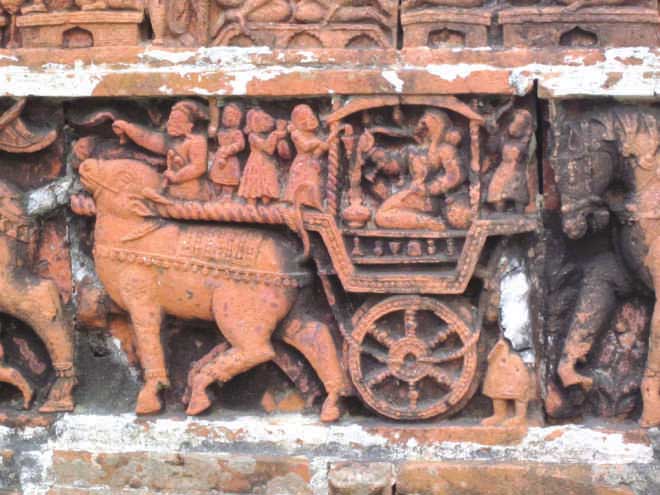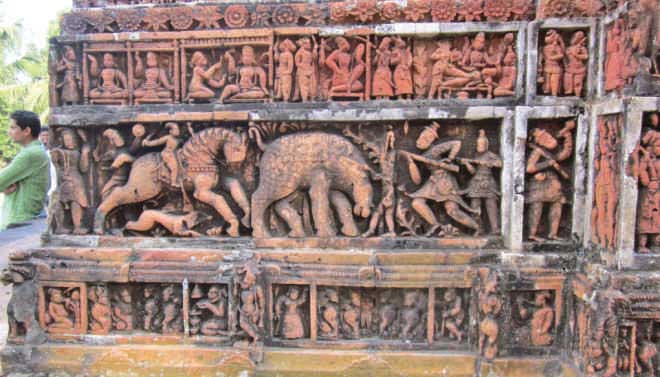A CONVERSATION IN CLAY

Both smoking and ox cart travelling must offer ground for contemplation – all the more so in a frozen moment such as hers. The hookah's coals can never run out of heat. The ox cart will never arrive. She cannot age for she is made of clay. She is but an intricate decoration: part of a brick in Dinajpur's Kantaji Temple.
“There would've been a guild of artisans, probably fifty or more people,” says Dr Niru Shamsunnahar, Deputy Keeper at the Department of History and Classical Arts. “They would've had a master craftsman as leader, who by tradition specialised in architecture, painting and sculpture – all three.” Researcher and historian, she has studied terracotta for over a decade.
“The guild would roam, offering services at palaces and the houses of wealthy landlords. They even had blueprints from which a patron could choose.”
Being an artisan was a multigenerational profession within a family. Artisans were held in high esteem in Bengal – but while the names of some from the earlier Pala Dynasty have been preserved, the names of the artisans responsible for Kantaji are unknown.
Kantaji was built at Kantanagar not far from the bank of the River Dhepa by Dinajpur's rulers, with construction commissioned by Maharaja Prannath in 1704 and completed during the reign of his adopted successor Maharaja Ramnath some decades later. The late medieval Hindu temple built in navaratna style originally featured nine spires, destroyed in the earthquake of 1897.

Needless to say the visitor to Kantaji will be struck by the staggering intricacy of the terracotta plaque embellishments on every wall. Needless to say they will leave with a sense of awe and wonder.
“There are other examples of terracotta work in Bangladesh,” says Dr Shamsunnahar, “but Kantaji is best preserved.” Terracotta design was a hallmark of ancient Bengal with many further examples in Paschimbanga, but not the rest of India. “There is not much rock in Bengal. Clay is pliable and soft. It was a natural choice.”
From studying fourteenth century texts Dr Shamsunnahar was able to understand the complicated processes employed by artisans to give strength and religious energy to their constructions. River clay would be mixed with tree sap from bat, tetul and bael – banyan, tamarind and wood apple trees – among others. Silver, gold, turmeric and milk were added. As well as religious favour such recipes brought better protection from humidity and salinity.
“Most images would have been produced and reproduced using wooden casts called die, according to the blueprint plan” she explains, “with hand work reserved for important pieces such as images of gods, goddesses and royalty.”
At Kantaji the upper portions of the walls illustrate the Hindu epics, the Mahabharat and the Ramayana, while the lower sections feature daily life scenes. Especially if a patron was liberal, artisans were permitted to include a large degree of their own creativeness in depicting such scenes, what becomes a social story, a conversation in clay.
There's a rich merchant resting on a takia pillow in a sedan chair. There's a hunting dog. There's a large, thin nouka boat illustrating the sport of racing and smaller nouka dinghies used more simply to cross a river. There's a decorated horse, an elephant with a fancy saddle and a large unknown beast that's come out of the forest during a hunt. And there's that lady in the ox cart, still reclining, still smoking…
“These images are inspired by the thinking and feeling of the artisans,” says Dr Shamsunnahar, “by what they saw and knew around them.”

The ox powering the cart is robust, healthy and decorated by a row of bells or trinkets around its body. It's an ox of affluence unlike the thin and bony ox of a farmer today. His head is aloft. He's all pride.
Three attendants, meanwhile, are positioned behind the driver on the ox's back, a fourth on the back of the cart behind her. She is no ordinary citizen.
“In an earlier era they were called nagar-nati,” says Dr Shamsunnahar, which might be translated as courtesan or lady of the court. Such women were born into ordinary families, but at an early age their beauty and cultural talents were noted, and the girl would be taken from her father's home to the royal court.
There they would be trained in the arts and educated. Nagar-natis would sing and dance, recite poetry and tell jokes. They were expected to be brilliant, accomplished, informed, wise and witty. And – choosing their own partners – they were expected to be expert in the art of love-making too. They were not allowed to marry. Later in life a nagar-nati might become tutor to the younger generation.
“Such women often grew wealthy and powerful due to their proximity to the rulers,” says Dr Shamsunnahar, “They had influence.”
Although at a later time the status of such women was increasingly overshadowed with associations of prostitution and immorality, originally they were considered as bastions of high culture entrusted with the pinnacle achievements of civilisation.
But what is it she is contemplating? Has she let her mind slip back to the day she left her family as a girl? Or is her mind set to the future, considering a latest political manoeuvre to notch up gratitude with the Maharaja or one of his minions?
Dr Shamsunnahar remembers from her own childhood how the farmer's wives would smoke for leisure. I remember the big wooden wheels of the Bangladeshi village ox carts from a good decade ago – they were plain wood, not with decorated spokes like the wheels of the cart that carry Kantaji's lady. But while our memories must of course pass and, with time, fade, those luxurious ox-cart wheels can never turn for they are made of clay.


 For all latest news, follow The Daily Star's Google News channel.
For all latest news, follow The Daily Star's Google News channel. 




Comments